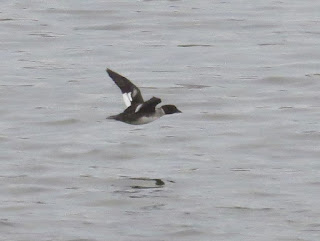Here are a few images from WMBC Reserve at Belvide today
It had been a very misty and frosty start to my latest visit to the WMBC Reserve at Belvide. As the mist cleared this adult Mute Swan decided to go for a fly. Immediately after breeding started there was a congregation of over 100 non-breeding birds here. These have gradually reduced – many no doubt feeding on the many wet grassy floods in the area.
Not exactly the most elegant of landings from these Gadwall – the small white area on the back of the inner part of the wing identifies at long range.
If you take enough photos of flying drake Mallards sooner or later one will be in focus!
A flight shot of a drake Goldeneye – note the white area on the face. Note in particular the extent of the white across the wing and compare ...
... with a flying duck Goldeneye on which the white only goes half way across the wing.
Not a species to be expected in the Midlands almost in to December, though Common Sandpipers do regularly over-winter along the South Coast. Here it has found a morsel.
A clear shot showing the pale fringes to the back feathers and the white notches on the folded wings. The very rare (in the UK) Spotted Sandpiper lacks these notches: otherwise because it loses its spots in winter it is hard to separate from Common Sandpiper.
The best I could do across the whole width of a still rather foggy lake. An adult winter Great Black-backed Gull dwarfs the adult winter Lesser Black-backed Gull behind it. This is a rather strange bird (not another ...!) in that the mantle is not as dark as the folded wing tips and no darker than the other adult winter Lesser Black-backed Gull on the right of the picture. It also seems to have a dark eye. Lastly while the bill is large it is not noticeably ‘brutish’. (Canada Geese, Cormorants and a single Greylag Goose as well if you look hard).
Another odd feature was the dark marking on the nape – Great Black-backed Gulls are not supposed to get any dark head streaks in winter. The size of the white spots in the folded wings supports the Great Black-backed Gull identification and, though not captured here, it scratched its head with pink, not yellow, feet. (a drake Wigeon has been added to the background).
What seems to be a juvenile male Pied Wagtail – just a few adult black feathers showing on the back.
You have to be alert for food to turn up anywhere on the wind-driven spume. What seems to be a faint yellow wash on the face confirms a juvenile – perhaps immature would be a better description.
Spent a long while with these tits. Willow Tits and Marsh Tits are notoriously hard to separate and most easily identified by voice. Today, with temperatures hovering around freezing, they were not disposed to call and I needed to try and get decent photos to make certain. Here are two what I eventually decided were Marsh Tits. The features to look for are: the small black ‘bib’ – ID guides used to call it a ‘Hitler moustache’ but we probably can't say that these days: and the warm tones on the belly and the front of the flank that ‘bleeds’ behind the cheeks. Rather confusingly this bird shows a hint of a ‘pale panel’ in the folded wing which is supposed to indicate Willow Tit. It would normally be much more prominent on that species.
The pale panel in the wing does looks more prominent here. However we see on the back bird that the black crown extends widely down the nape confirming Marsh Tit.
Here for a size comparison with a female Chaffinch. Many birds here are ringed – there is a very active ringing group at the lake (properly licensed of course).
Not as crisp as I would like but a good view of the extensive black down the nape.
This shows a feature that I had never read about before but which one of the other birders present mentioned – Marsh Tits have a pale patch at the base on the upper bill’s cutting edge. It is almost impossible to see this ‘in the field’ and indeed on this photo it is hard to be certain it is not just light reflection. I found this information at Two Owls Birding
Here. That link illustrates another feature not mentioned in bird books. Willow Tits look ‘clean’ as if they have just had a bath. Marsh Tits look rather ‘muddy’.
All the other photos were taken at the feeder which I don’t normally like to do. The birds tended to ‘grab and go’ and this was the only shot I managed of a bird in a more natural habitat.
I know Dunnocks are thought of as the archetypical ‘small brown job’ but they are a very delicately marked species.
Here is another having a good poke about to get its feathers in order.
Its back could do with a touch more smoothing. The bird’s attention seems to be drawn to trying to read the number on its ring.
Also proudly showing off its ring is this Robin.
(Ed Wilson)
































































